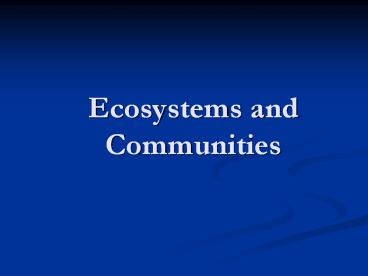Ecosystems and Communities - PowerPoint PPT Presentation
1 / 41
Title:
Ecosystems and Communities
Description:
Ecosystems and Communities Tropical Savanna Deserts Temperate Grassland Temperate Woodland and Scrubland Temperate Forest Northwestern Coniferous Forest Boreal Forest ... – PowerPoint PPT presentation
Number of Views:157
Avg rating:3.0/5.0
Title: Ecosystems and Communities
1
Ecosystems and Communities
2
March 22, 2011
- Turn in your cycles of matter hw!!
- Warm Up How is the flow of energy different from
the flow of matter? - Anticipation Guide!
3
Competition
- Occurs when organisms of the same or different
species attempt to use an ecological resource in
the same place at the same time. - Resources-any necessity of life
4
Competitive Exclusion Principle
- No two species can occupy the same niche in the
same habitat at the same time.
5
Predation
- Interaction in which one organism captures and
feeds on another organism. - Predator vs. Prey
- Give me some examples!
6
Predation
7
Symbiosis
- Any relationship in which two species live
closely together. - Types of Symbiotic Relationships
- Mutualism-both benefit, ? ?
- Ex. Flowers and insects
- Commensalism-one member benefits, other neither
helped nor harmed, ? - - Ex. Barnacles and whale
- Parasitism-one helped, one harmed, ? ?
- Ex. Tapeworms and mammals
8
Mutualism ? ?
9
Commensalism ? -
10
Parasitism ? ?
11
Ecological Relationships
- After a student reads the scenario, hold up
which card you think BEST APPLIES. - Commensalism
- Mutualism
- Parasitism
- Predation
12
Symbiotic Relationships
- Complete the manipulative set with your partner.
Call me to check on it! - Anticipation Guide recap!
- When finished, start the handout. Finish for
hw!!! - Circle the correct relationship (a, b or c)
- Write which type of symbiosis that relationship
is.
13
March 23, 2011
- Bring book tomorrow and Friday!!!
- Quiz on Friday Chapters 3 and 4 No notes!
- Warm Up
- What is symbiosis?
- What are the three symbiotic relationships?
- Review Cycles/Anticipation Guide/Exit Ticket
- Create a symbiotic bat!
- Definition
- Example
- Picture of what it is
14
March 24, 2011
- Bring Book Again Tomorrow!
- Symbiosis PP Review with homework!
- Symbiosis Worksheet PART I ONLY!!!!
15
Biotic vs. Abiotic Factors
- Together determine survival and growth of an
organism and productivity of the ecosystem. - Biotic Factors
- Abiotic Factors
- Niche
16
A. biotic factors- the biological
influences on organisms within an
ecosystem -living things! B. abiotic
factors-physical or nonliving factors that
shape an ecosystem -nonliving things! C.
niche-the full range of physical and biological
conditions in which and organism lives and how
it uses them
17
NICHE describes the job of the organism within
the ecosystem it is the full range of physical
and biological conditions it lives in and out it
uses those conditions!
Here is a picture of a worm and its nichehow can
we describe a worms niche? Describe your
niche!!
18
Biotic Factor Abiotic Factor
Definition 3 Examples
Definition 3 Examples
How is a niche different than a habitat????
19
The Role of Climate
- Are all species able to tolerant all
environmental conditions? - Temperature, precipitation and other
environmental factors in the atmosphere combine
to produce climate and weather.
20
Weather vs. Climate
- Weather-day to day
- Climate-year to year
- Climate is caused by many factors.
- The energy of incoming sunlight drives Earths
weather and in turn determines climate.
21
The Greenhouse Effect
- Atmospheric gases trap heat energy and maintain
Earths temperature range. - Gases act like a glass window of a greenhouse.
- Heat is retained by layer of greenhouse gases
creating effect.
22
Greenhouse Effect
- Greenhouse gases allow solar energy to penetrate
the atmosphere. - Converted into heat energy as it hits the Earths
surface and radiates back into the atmosphere. - But, the gases do not allow the escape as easily
as the entrance. - In turn, heat is trapped in the atmosphere.
23
Latitudes Effect on Climate
- Earth is tilted, so solar radiation strikes at
different parts of Earths surface at angles that
vary at different times of year. - This causes three climate zones polar, temperate
and tropical
24
Winds and Ocean Currents
- The unequal heating of Earths surface drives
wind and ocean currents transporting heat
throughout the biosphere. - The upward movement of warm air and downward
movement of cool air create air currents or winds
moving heat. - The flow of water due to temperature as well as
by winds causes ocean currents. - Ocean currents also transport heat energy and in
turn affect weather and climate.
25
Ecological Succession
- Ecosystems constantly change due to natural and
human disturbances. - Series of unpredictable changes
- Primary succession succession that occurs on
surfaces with no soil - Ex. After a volcanic eruption
- Pioneer species
- Secondary succession soil is present
- Ex. Land cleared for farming is abandoned or
after wildfires in woodlands
26
Primary Succession No soil!
27
Secondary Succession
28
Aquatic Ecosystems
- Determined primarily by depth, flow, temperature,
and chemistry of the overlying water. - Marine saltwater/oceanic
- Limiting Nutrient nitrogen!
- Freshwater flowing (rivers) or standing (lakes,
ponds) - Limiting Nutrient phosphorus!
29
Coral Reefs
- Named for coral animals with calcium carbonate
skeletons
30
Biomes
- Complex terrestrial communities that covers a
large area - Tolerance ability to survive and reproduce under
conditions that differ from optimal ones - Microclimate
31
Tropical Rain Forest
32
Tropical Dry Forest
33
Tropical Savanna
34
Tropical Savanna
35
Deserts
36
Temperate Grassland
37
Temperate Woodland and Scrubland
38
Temperate Forest
39
Northwestern Coniferous Forest
40
Boreal Forest
41
Tundra































